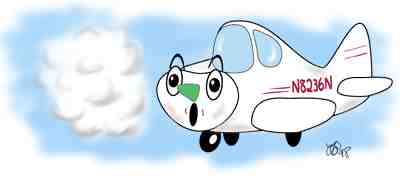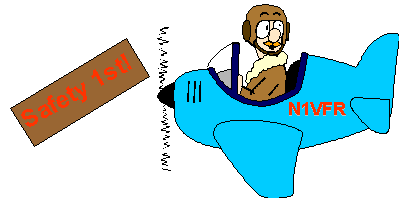 “Ouch!” I muttered after turning around too quickly and banging my head on the leading edge of the wing during preflight. I haven’t even started the engine and I’m already an aviation casualty. The reality is that you don’t have to be airborne to have trouble come-a-callin’. In fact, you may be surprised at the variety of accidents that frequently occur on the ground even before we get into the airplane. Our mind-set as we meander around the familiar airport environment is far different from our focus in the air. Often our mind may drift as we become preoccupied with a pending flight or the price of Avgas. In Part I of “Grounded” we will explore the hidden dangers of the parked airplane.
“Ouch!” I muttered after turning around too quickly and banging my head on the leading edge of the wing during preflight. I haven’t even started the engine and I’m already an aviation casualty. The reality is that you don’t have to be airborne to have trouble come-a-callin’. In fact, you may be surprised at the variety of accidents that frequently occur on the ground even before we get into the airplane. Our mind-set as we meander around the familiar airport environment is far different from our focus in the air. Often our mind may drift as we become preoccupied with a pending flight or the price of Avgas. In Part I of “Grounded” we will explore the hidden dangers of the parked airplane.
Most ground-related accidents aren’t well-publicized. The smoking holes get all the press. Even a plane running out of gas and making a successful landing on a road will be “page one” news. Ground accidents may not have much pizzazz, but they can be serious and costly. It can turn an otherwise good flying day into a disaster and even a lawsuit. The examples that I present are real and are taken from my claims files.
Parked planes seem to be a magnet for airport vehicles, fuel trucks, other planes, and spaced-out pilots driving their cars. I have had more than one claim reported where the pilot was driving his own car and hit his own plane. We tend to be much more attentive driving in a supermarket parking lot where we can anticipate trouble. Oh yes, and just like in the parking lots, not everyone will stop and leave a note after hitting your plane. Sad and dangerous, but true. Even if you have only been gone from your plane for a few minutes, always do a walk-around before you get in. I have handled claims where pilots have become airborne unaware that their planes were damaged by someone on the ground who didn’t stop to leave a note.
If you are fortunate enough to have your airplane in a hangar, the odds are that you will probably be unfortunate enough at some point to come down with a case of hangar rash. Shoe-horning planes in and out of a hangar is a cumbersome task that carries with it a certainty that the plane will be damaged if 100 percent care and attentiveness is not given every time you move that plane. Are the hangar doors fully open? Is the tug or tow bar mechanically sound and properly secured to the plane? Any objects (like cars or other planes) in close proximity? Do you know how far back can you push the plane before it hits the rear hangar wall? Keep focused on the task at hand and not the flight or other distractions.
 Failing to use chocks is a good way to get an unwanted surprise. I have handled a lot claims where unchocked airplanes have rolled away on seemingly level ground into other planes, buildings, or vehicles. The resulting damage can be awesome. Don’t deceive yourself by thinking that because you are nearby or will only be gone for a few minutes that nothing will happen. The gradient of seemingly flat ground can be deceiving and once a plane starts rolling it quickly builds a momentum that can’t be stopped by human strength alone. Even on level ground, all it takes is a well-placed breeze, prop blast, or jet thrust to set things in motion. Some pilots think that the heavy weight of larger planes will keep it from rolling – Wrong! If it has wheels it can roll and with the close quarters of parking at airports it only takes a few feet of movement to have a collision which is both costly and embarrassing. Don’t rely on parking brakes alone. Always carry a set of chocks in your plane and use them when you park.
Failing to use chocks is a good way to get an unwanted surprise. I have handled a lot claims where unchocked airplanes have rolled away on seemingly level ground into other planes, buildings, or vehicles. The resulting damage can be awesome. Don’t deceive yourself by thinking that because you are nearby or will only be gone for a few minutes that nothing will happen. The gradient of seemingly flat ground can be deceiving and once a plane starts rolling it quickly builds a momentum that can’t be stopped by human strength alone. Even on level ground, all it takes is a well-placed breeze, prop blast, or jet thrust to set things in motion. Some pilots think that the heavy weight of larger planes will keep it from rolling – Wrong! If it has wheels it can roll and with the close quarters of parking at airports it only takes a few feet of movement to have a collision which is both costly and embarrassing. Don’t rely on parking brakes alone. Always carry a set of chocks in your plane and use them when you park.
Accidents on the ramp apply not only to airplanes, but to people as well. I have handled a number of serious injury claims (broken arms, knees, teeth, and facial injuries) that came simply from people tripping over tie down fasteners, ropes, and chains. Passengers have also received similar injuries from falling while getting in and out of aircraft, especially on low-wing planes, and as incredible as this may seem, both pilots and passengers are still departing this lifetime after close-encounters with moving propellers. Never allow anyone to board, deplane, or approach an aircraft with a running engine.
 As comfortable as we might be in an airport environment, it is a foreign land to our non-aviation visitors. The temptation to wander about and sight-see is normal. It is your duty to supervise your guests like a mother hen and advise of them of the hazards. On the ramp make sure that you escort your guests at all times and do not let them wander off. Children and pets need special attention in this regard. Always monitor and assist passengers getting in and out of your plane.
As comfortable as we might be in an airport environment, it is a foreign land to our non-aviation visitors. The temptation to wander about and sight-see is normal. It is your duty to supervise your guests like a mother hen and advise of them of the hazards. On the ramp make sure that you escort your guests at all times and do not let them wander off. Children and pets need special attention in this regard. Always monitor and assist passengers getting in and out of your plane.
In Part II, “Grounded – After the Engine Starts,” we will explore some of the unique and little known hazards facing a pilot during taxi operations.
Editor’s Note: This article was written by Ken Steiner prior to his retirement from the United States Aircraft Insurance Group as a Vice-President and Claims Manager. During his career, Ken investigated thousands of aircraft accidents involving small planes, crop dusters, helicopters, corporate aircraft, and airliners. He has been on-site at over 100 fatal aircraft accident investigations. He is currently an Aviation Investigative Consultant and is also a Pilot and Tactical Flight Officer for the San Mateo County Sheriff’s Air Support Unit. He owns a Cessna 182 based at San Carlos and holds ATP and CFI certificates with over 5000 flying hours.


